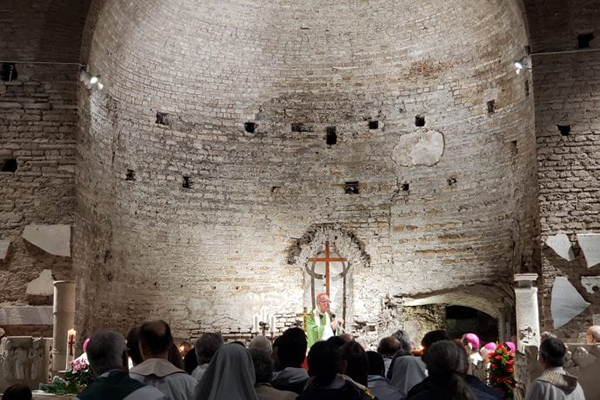
By Inés San Martín
ROME (Crux) — Some 40 bishops participating in the Synod of Bishops on the Amazon gathered October 20 in the Catacombs of St. Domitilla in Rome to renew a pact signed in 1965 by 42 prelates at the Second Vatican Council calling for a poor church.
Though both “Pacts of the Catacombs” were inspired by a commitment to building a poor church for the poor, there are striking differences between the 1965 original and the one signed this time around, including length.
This week’s pact is rooted in the Amazon, and some elements may be harder to embrace by the universal Church, as the original declaration was intended to be.
Titled “Pact of the Catacombs for the Common Home, for a Church with an Amazonian face, Poor and Servant, Prophetic and Samaritan,” Sunday’s declaration among other points calls for recognition of the “real diakonia of a great number of women who today direct communities in the Amazon.”
Another difference is that this one was signed by lay people, including women. As one woman went up to sign, she referred to herself as a “synod mother,” a parallel to bishops participating in the Oct. 6-27 Synod of Bishops on the Amazon who are called “synod fathers.”
Also expected to sign were a Lutheran pastor and a pastor of the Assemblies of God who attended a Mass celebrated by Brazilian Cardinal Claudio Hummes, the relator, or chairman, of the Synod of Bishops on the Amazon.
The new pact contains 14 points, the first of which is a call to defend the Amazon rainforest in the face of global warming and depletion of natural resources. The first three, in fact, concern care for God’s creation and a reminder that man is not the owner of “Mother Earth, but rather the sons and daughters,” called to be caregivers.
The original 42 bishops who signed the 1965 pact pledged to “try to live according to the ordinary manner of our people in all that concerns housing, food, [and] means of transport…. We renounce forever the appearance and the substance of wealth, especially in clothing … and symbols made of precious metals.”
In the Amazon version, it’s not until the fourth point that signatories affirm their “preferential option for the poor,” underlining native peoples in particular, making them protagonists in society and in the Church, helping them “preserve their lands, cultures, languages, stories, identities and spiritualities.”
The following point calls on the Church to abandon “all types of colonist mentality and posture,” welcoming the cultural, ethnic and linguistic diversity in dialogue “with all spiritual traditions.”
The bishops also pledged to denounce violence towards native peoples, to walk ecumenically with other Christians and to establish “a synodal lifestyle where representatives of original peoples, missionaries, lay people, because of their baptism and in communion with their pastors, have voice and vote in diocesan assemblies, in pastoral and parish councils and, ultimately, everything that concerns the governance of the communities.”
Proclamation of the “liberating novelty of the Gospel of Jesus in welcoming the other and the one who is different” comes in point seven.
Signatories also pledged to recognize ecclesial ministries in the communities, and to go from “pastoral visits to pastoral presence” to ensure that the right to the “Table of the World and the Table of the Eucharist are effective in all communities.”
The pact also calls for finding new paths of pastoral action, with particular attention to the peripheries, such as migrants, workers and the unemployed.
Facing what signatories call an “avalanche of consumerism,” they pledge to assume a “happily sober lifestyle, simple and in solidarity with those who have little or nothing; to reduce the production of garbage and the use of plastics, favoring the production and commercialization of agro-ecological products; and using public transport whenever possible.”
For the occasion, Cardinal Hummes wore the stole of late Brazilian Archbishop Helder Camera of Olidna and Recife, the driving force behind the 1965 declaration.
When Mass ended, Cardinal Hummes gave the stole to retired Austrian Bishop Erwin Kräutler of Xingu, Brazil, which is located in the Amazon, saying he deserves to carry the “relic.” The Austrian is believed to have been the architect of this new Catacombs Pact.
Italian Bishop Luigi Bettazzi, now 95 and the only original signatory from 1965 still living, wasn’t in the Catacombs of Domitila, some five miles from St. Peter’s Square, due to health and advanced age. He was, however, informed, and according to organizers, sent his regards.
Peruvian Cardinal Pedro Ricardo Barreto told Crux that Pope Francis “knows everything, he’s being properly informed.” Speaking with journalists after the Mass, Hummes said that the pope hadn’t “formally” been told about the renewal of the pact, but that he would be brought up to speed.
In his homily, the Brazilian delivered a strong critique of accumulation of wealth, defining money as the driving force of “everything that is evil today,” including war and violence.
“We ask of the synod new paths, better conditions to be able to proclaim the word,” Cardinal Hummes said, saying that one has to be insistent, even with those opposed to the Kingdom of God.
He said that the Catacombs is a “Holy Land,” where the blood of the first Christian communities was shed, and which served as a refuge to those persecuted for their faith in God.
“May God give us the strength he gave Christians of that time,” Cardinal Hummes said.
Speaking about the Church as semper reformanda, meaning, in a constant state of reform, Cardinal Hummes said changes must always be inspired by those “primitive times of the Church.”
